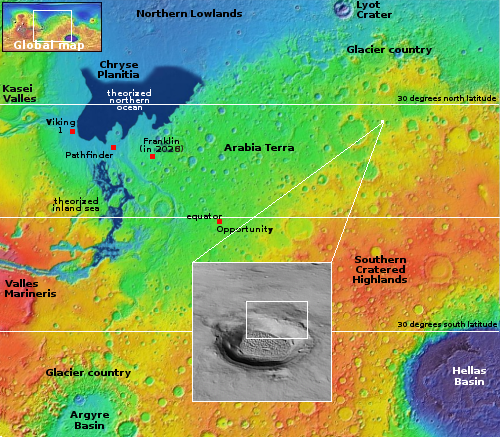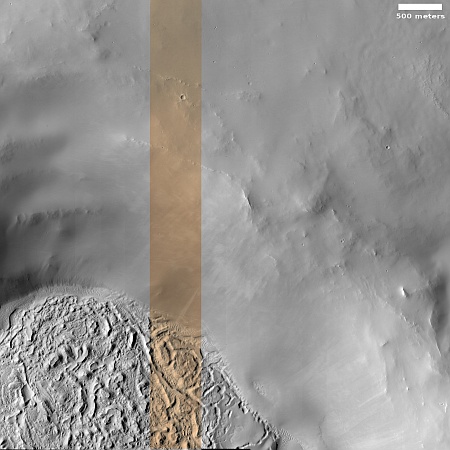Mars geology that only makes sense by digging deeper
Today’s cool image is a perfect example of why nothing in science research should ever be taken at face value, without digging a bit deeper. The picture to the right, rotated, cropped, reduced, and sharpened to post here, was taken on October 5, 2023 by the high resolution camera on Mars Reconnaissance Orbiter (MRO).
First an important technical point. Though the electronics unit for one of the camera’s color filters is still not working — causing a blank strip down the center of all black & white images, the camera team has gotten around this problem by inserting in that strip other color filter data, thus creating a complete image as you see to the right. This work-around means that MRO’s capabilities, though showing signs of age, will continue almost as good as before.
As for the image itself, when I first looked at it, I was baffled by the striking contrast between the mottled and rough ground in the lower left, and the almost featureless and smooth terrain everywhere else. Why this sudden transition? What could cause it? That inexplicable contrast demanded I post it as a cool image.

Further research however showed that the cause of the contrast was incredibly simple. On the overview map to the right the area covered by the photo above is indicated by the rectangle inside the inset.
The wider view reveals that this rough terrain is the floor of a 5-mile-wide unnamed crater in the equatorial regions of Mars. Even though crater is abot 1,300 feet deep and the crater walls are steep, the walls and the rim are relatively smooth and featureless with the sun’s angle producing few shadows, so that the crater rim blended into the northern plateau and was not recognizable as a steep slope in the high resolution image. What appeared to be a sudden transition from smooth to rough terrain was instead the difference between a smooth plateau and the floor of a crater.
That floor however is significant. It looks very much like glacier debris, but the crater is at 26 degrees north latitude, in the dry Martian tropics where no such ice should be. This picture therefore reinforces the conclusion of the scientists who recently compiled a global map of Mars’ near surface ice, and said that the data suggested that near surface ice existed in this part of the Martian tropics. This picture strengthens that conjecture.
On Christmas Eve 1968 three Americans became the first humans to visit another world. What they did to celebrate was unexpected and profound, and will be remembered throughout all human history. Genesis: the Story of Apollo 8, Robert Zimmerman's classic history of humanity's first journey to another world, tells that story, and it is now available as both an ebook and an audiobook, both with a foreword by Valerie Anders and a new introduction by Robert Zimmerman.
The ebook is available everywhere for $5.99 (before discount) at amazon, or direct from my ebook publisher, ebookit. If you buy it from ebookit you don't support the big tech companies and the author gets a bigger cut much sooner.
The audiobook is also available at all these vendors, and is also free with a 30-day trial membership to Audible.
"Not simply about one mission, [Genesis] is also the history of America's quest for the moon... Zimmerman has done a masterful job of tying disparate events together into a solid account of one of America's greatest human triumphs."--San Antonio Express-News
Today’s cool image is a perfect example of why nothing in science research should ever be taken at face value, without digging a bit deeper. The picture to the right, rotated, cropped, reduced, and sharpened to post here, was taken on October 5, 2023 by the high resolution camera on Mars Reconnaissance Orbiter (MRO).
First an important technical point. Though the electronics unit for one of the camera’s color filters is still not working — causing a blank strip down the center of all black & white images, the camera team has gotten around this problem by inserting in that strip other color filter data, thus creating a complete image as you see to the right. This work-around means that MRO’s capabilities, though showing signs of age, will continue almost as good as before.
As for the image itself, when I first looked at it, I was baffled by the striking contrast between the mottled and rough ground in the lower left, and the almost featureless and smooth terrain everywhere else. Why this sudden transition? What could cause it? That inexplicable contrast demanded I post it as a cool image.

Further research however showed that the cause of the contrast was incredibly simple. On the overview map to the right the area covered by the photo above is indicated by the rectangle inside the inset.
The wider view reveals that this rough terrain is the floor of a 5-mile-wide unnamed crater in the equatorial regions of Mars. Even though crater is abot 1,300 feet deep and the crater walls are steep, the walls and the rim are relatively smooth and featureless with the sun’s angle producing few shadows, so that the crater rim blended into the northern plateau and was not recognizable as a steep slope in the high resolution image. What appeared to be a sudden transition from smooth to rough terrain was instead the difference between a smooth plateau and the floor of a crater.
That floor however is significant. It looks very much like glacier debris, but the crater is at 26 degrees north latitude, in the dry Martian tropics where no such ice should be. This picture therefore reinforces the conclusion of the scientists who recently compiled a global map of Mars’ near surface ice, and said that the data suggested that near surface ice existed in this part of the Martian tropics. This picture strengthens that conjecture.
On Christmas Eve 1968 three Americans became the first humans to visit another world. What they did to celebrate was unexpected and profound, and will be remembered throughout all human history. Genesis: the Story of Apollo 8, Robert Zimmerman's classic history of humanity's first journey to another world, tells that story, and it is now available as both an ebook and an audiobook, both with a foreword by Valerie Anders and a new introduction by Robert Zimmerman.
The ebook is available everywhere for $5.99 (before discount) at amazon, or direct from my ebook publisher, ebookit. If you buy it from ebookit you don't support the big tech companies and the author gets a bigger cut much sooner.
The audiobook is also available at all these vendors, and is also free with a 30-day trial membership to Audible.
"Not simply about one mission, [Genesis] is also the history of America's quest for the moon... Zimmerman has done a masterful job of tying disparate events together into a solid account of one of America's greatest human triumphs."--San Antonio Express-News



The MRO team deserves some kudos for that slight of tech. Getting some data in the gap is better than no data. Love it.